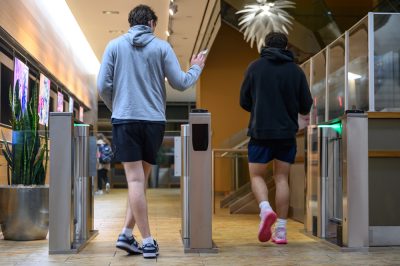Boston University installed new turnstile scanners at Student Village II and Claflin Hall, as an initiative to increase security measures in all residence halls across campus.

Kelly Nee, chief safety, security and preparedness officer for BU, wrote in an email that the scanners are for “enhanced access, control and visitor policy monitoring.”
The scanners have two waist-high doors that swing open when a student swipes their BU ID.
Paul Riel, associate vice president of auxiliary services at BU, said a convenient aspect of the new turnstiles is that they operate faster and provide more information compared to the previous model.
“We thought these turnstiles were aligned with where technology is headed,” Riel said. “The optical scanners have run their effective force for some time, but we just felt these new turnstiles … give us a higher level of safety.”
Riel said the scanners are part of an initiative to install turnstiles across all 12 campus residences. Eight more turnstiles will be installed, but there is no set timeline on the project, he said.
Riel said scanners will improve security guards’ efficiency.
“It’s a tool that provides them a greater tool to do their jobs more effectively,” Riel said.
The turnstiles were first installed in Mugar Memorial Library and are also present in dining halls, such as Marciano Commons and West Campus dining hall locations.
Lizzie Victori, a junior in the College of Communication and resident of Student Village II, said the turnstiles are slower, louder and more inconvenient compared to the old scanners, but she is aware BU installed them for the safety of the students.
“I guess they really just don’t want people with not such good intentions to get in,” she said. “There’s been issues in the past of people getting into the dorms when they’re not supposed to or people saying they live here when they don’t.”
However, Victori pointed out that this security measure could be evaded since students can sign in whoever they want.
The turnstiles initiative comes after an unaffiliated 33-year-old man jumped to his death from the 26th floor of StuVi II in February. BU students expressed concerns about student safety and security in on-campus housing.
When asked about if this incident, and incidents similar to it, played a role in BU getting the scanners Nee wrote, “breaches of security do play a role in how we assess need and identify gaps so that we can take corrective actions,”
Mateo Jaime Luna, a sophomore in the College of Arts and Sciences and a resident of Claflin Hall, prefers the new scanners, saying that the only issue he has had is that it can be difficult to walk out at the same time someone walks in.
“I think it definitely adds a safety feature that a lot of people would now have to overcome if they wanted to do something in Claflin,” he said.
Cassidy Young, a sophomore in Sargent College of Health and Rehabilitation Sciences, said she feels BU does a good job with safety overall.
“I’ve lived on campus freshman year and now again sophomore year,” Young said. “I definitely in my housing have felt safe. Walking around campus for being in a city, I felt pretty safe too.”
Victori said she feels safe in BU dorms but the rest of campus is “a free for all.”
“I feel like the rest of the campus is hard to monitor just because it’s so public,” she said. “Anybody could just walk down Comm. Ave. and just go into whatever building.”
Despite this openness, Victori does not think there are safety measures the University needs to take because of this, a similar thought shared by Jaime Luna.
“If we had more safety features to the buildings where you study and stuff, a lot of people are rushing in and out,” Jaime Luna said. “We’re a college that accommodates thousands of students so I feel like it would add a buffer rather than a safety thing and it would become a safety hazard.”
Nee described the BU security systems as always “developing and evolving.”
“We always strive to find the right balance with security without over securitizing in any particular location,” Nee wrote. “We keep an eye out for the latest technologies.”
In her new role as Chief Safety, Security and Preparedness Officer, Nee wants to create more policies that work for everyone.
“I look across the entire university to see how we can improve the security posture, again, by striking the right balance, and working collaboratively with all those affected by those security measures,” Nee wrote.

















































































































